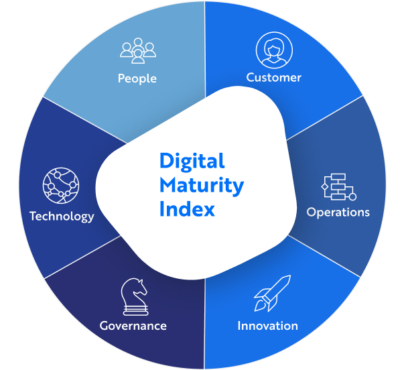
In the rapidly evolving digital landscape, companies that consistently invest in digital innovation find themselves in a virtuous cycle, spiraling upwards and onwards. This continuous investment creates a momentum that not only propels business growth but also establishes a strong, forward-looking digital presence. Conversely, those lagging in digital initiatives often find themselves caught in a vicious cycle, struggling to keep pace and losing ground in the competitive market.
The Upward Spiral: Advantages of Being a Digital Leader
Companies that prioritize and continuously invest in their digital capabilities experience a multitude of benefits:
Attracting Top Talent: Digital leaders become talent magnets. Professionals, especially the tech-savvy and innovative, gravitate towards organizations that are at the forefront of digital transformation.
Gaining Funding and Collaborations: These companies are more likely to receive funding from investors who recognize the potential in digital advancements. Collaborations with research institutes and startups become more accessible, further fueling innovation.
Enhancing Publicity and Visibility: A robust digital presence boosts brand visibility and publicity. These companies often feature in media stories as pioneers, attracting more attention and creating positive brand associations.
Continuous Advancement: With each digital initiative, these companies build on their success, innovating continuously, and staying ahead of the curve in their respective industries.
Case Study: Tate Modern
One inspiring case study from Harvard Business School that exemplifies the virtuous cycle of continuous digital investment is the transformation of the Tate, a collection of major art galleries in the UK, including the renowned Tate Modern. Under the leadership of John Stack, Head of Digital Transformation, the Tate embarked on a journey to create its “fifth gallery,” an online presence. This initiative involved two digital strategy planning processes, transforming the Tate’s digital platform into a virtual space rich with engaging content, activities, experiences, and communities. This digital expansion was integrated into every aspect of the Tate’s operations, both physically and virtually, raising critical questions about organizational structure, marketing strategy, and return on investment. The case study highlights the Tate’s journey towards becoming a truly digital organization, where digital integration is the norm, showcasing the power of continuous digital evolution.
Ready to join the ranks of digital leaders? Evaluate your business’s digital maturity and start reaping the benefits today.
The Downward Spiral: The Plight of Digital Laggards
In contrast, companies that fall behind in their digital journey face an array of challenges:
Talent Acquisition Struggles: Without a strong digital focus, these companies struggle to attract and retain top talent, who prefer more digitally progressive environments.
Limited Publicity and Recognition: Lacking significant digital initiatives, these companies often miss out on media attention and public recognition, further diminishing their appeal to stakeholders.
Stagnation in Digital Transformation: A lack of advancement in digital areas leads to stagnation, making it increasingly difficult to initiate and successfully run digital projects.
The Vicious Cycle: This stagnation can lead to a downward spiral, where the lack of digital progress becomes a barrier to future growth and innovation.
Case Study: Eastman Kodak
A prominent case study that demonstrates the vicious cycle in digital transformation is the downfall of Eastman Kodak, a once dominant leader in the photography industry. Kodak, with a peak market capitalization of $31 billion in 1997, filed for bankruptcy by 2012, marking a significant decline. Key factors contributing to this downfall included:
Complacency and Over-Reliance on Legacy Business Models: Kodak remained invested in the film-based photography market, showing reluctance to transition emerging digital technologies for fear of cannibalizing its existing business.
Ignoring Technological Innovations: Despite inventing the first digital camera in 1975, Kodak failed to capitalize on this innovation, perceiving digital photography as a threat to its film business.
Misjudging Market Trends and Customer Needs: Kodak underestimated the speed at which consumers would adopt digital cameras and smartphones, leading to a misalignment with market trends and customer preferences.
The result was a failure to adapt to the digital era, leading to Kodak filing for bankruptcy and reemerging with a focus on digital imaging for businesses, a stark contrast to its past prominence.
This case study is a cautionary tale highlighting the importance of adapting to digital advancements and the risks of being caught in a vicious cycle of digital stagnation.
Breaking the Cycle and Embracing Digital Transformation
Assess Your Digital Maturity: Understand where your company stands in the digital landscape. Measuring your digital maturity is the first step in determining whether you are on an upward or downward spiral.
Take Proactive Actions: If you find your company in a vicious cycle, it’s time to break free. Embrace change, spread positive energy, and focus on progressing with your digital transformation. Small, consistent steps can lead to significant changes.
Monitor and Communicate Progress: Keep track of your digital transformation journey and communicate successes, both internally and externally. This communication builds momentum and fosters a culture of continuous improvement.
Patience and Belief: Digital transformation is a journey, not a sprint. Be patient and believe in your organization’s capabilities to evolve digitally. With time and persistent effort, your company can transition from a vicious to a virtuous cycle.
Concerned about falling behind in the digital race? Measure your digital maturity now and prioritize steps to ascend to the Upward Spiral.
Choosing Your Digital Path
In conclusion, the journey of digital transformation is marked by two distinct paths: the virtuous cycle of continuous advancement and the vicious cycle of stagnation and decline. Companies in the virtuous cycle, through relentless investment in digital innovation, enjoy numerous benefits like attracting top talent, securing funding, and gaining publicity, which further propels their growth. Conversely, organizations in the vicious cycle, often hindered by fear, complacency, or misjudged priorities, face challenges in talent acquisition, market relevance, and technological advancement, leading to a downward spiral.
The key to navigating this landscape lies in understanding your digital maturity, taking proactive steps for improvement, and consistently monitoring progress. Embracing change, spreading positive energy, and focusing on digital transformation are essential for breaking free from a vicious cycle and entering a virtuous one. Success in the digital era requires more than just adopting technology; it demands a strategic, holistic approach to transformation, underpinned by adaptability, foresight, and resilience.




